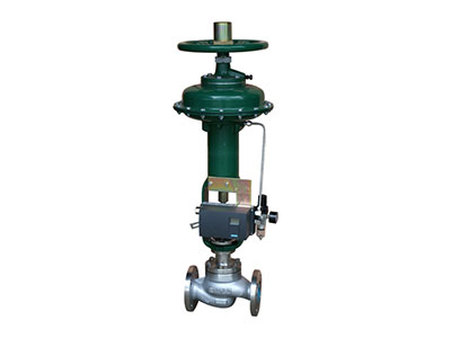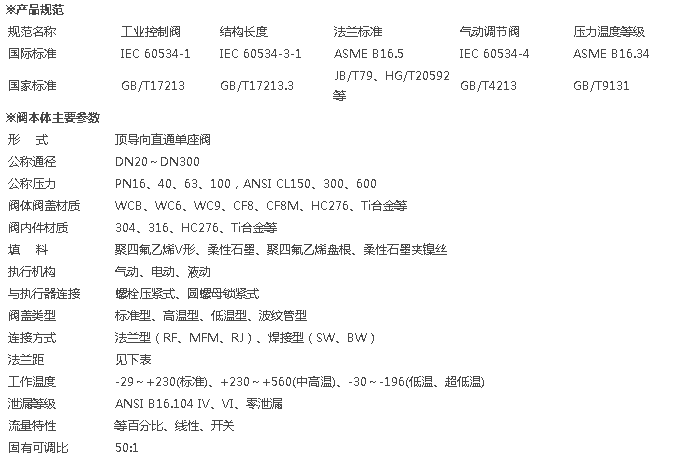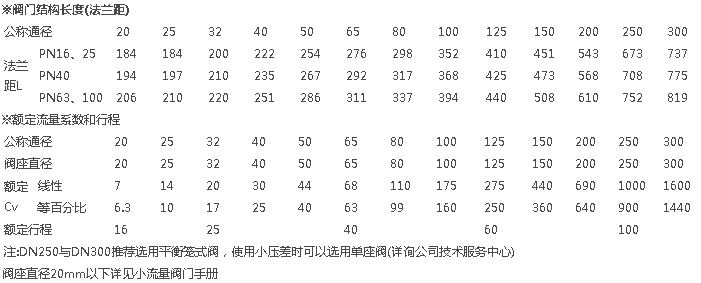

KLP series pneumatic quick-loading single seat control valve
brief introduction
KLP series pneumatic quick-loading single seat control valves adopt top-oriented unbalanced structure, with high strength, heavy load, S-streamline channel, small pressure drop loss, large flow coefficient, wide adjustable range and high accuracy of flow characteristics. The regulating valve is suitable for heavy load, normal or bad working conditions, close tightly, suitable for the control of various pressures and temperatures of fluids or gases, adapted to various actuators, and plays a regulating role. Fast-loading cage pressure valve seat design reduces lateral load and spool vibration, reduces friction, and prolongs the service life of control valve. Flow-open design, the direction of medium flow tends to open the control valve, and the micro-flow state can be controlled well. Special valve cages with noise reduction and cavitation resistance can be selected according to working conditions.


※Installation Notes
The newly designed and installed control system, in order to ensure the normal operation of the control valve while driving and ensure the safe operation of the system, the new valve should first check whether the nameplate marks on the valve are in conformity with the design requirements before installation. At the same time, the following items should be debugged: the basic error limit; the whole journey deviation; backlash; dead zone; leakage (in strict occasions).
If the control valve in the original system is overhauled, besides checking the above items, the sealing inspection of the filling box and the connecting parts of the old valve should also be carried out.
In the use of control valves, many are not caused by the quality of the control valve itself, but by improper installation and use of the control valve, such as the installation environment, installation location and direction of improper or unclean pipelines and other reasons. Therefore, when installing and using the control valve, the following aspects should be paid attention to:
(1)Regulating valves belong to field instruments, requiring that the ambient temperature should be in the range of - 25 - 60 C, and the relative humidity should be less than 95%. If it is installed in open air or high temperature situation, waterproof and cooling measures should be taken. Where there is a seismic source, it is necessary to stay away from the source or to increase measures to prevent vibration.
(2)Regulating valves should generally be installed vertically, and can be tilted in special cases. For example, when the angle of tilt is large or the self-weight of the valve itself is too large, support protection should be added to the valve.
(3)The pipeline equipped with control valve should not be too high from the ground or floor. Platform should be set up when the pipeline height is more than 2m to facilitate the operation of handwheel and maintenance.
(4)Before installation of the control valve, the pipeline should be cleaned to remove dirt and welding slag. After installation, in order to ensure that impurities do not remain in the body of the valve, the valve should be cleaned again, that is, all valves should be opened when entering the medium, so as to avoid impurities blocking. After using the handwheel mechanism, the original neutral position should be restored.
(5)In order to enable the production process to continue in case of failure or maintenance of the control valve, the control valve should bypass the pipeline, and special attention should be paid to whether the installation position of the control valve meets the requirements of the process.
(6)The installation of the electric part of the control valve shall be carried out according to the construction requirements of the relevant electrical equipment. If it is flameproof products, they should be installed in accordance with the requirements of "Installation Specification for Electrical Equipment in Explosive Hazardous Places". In use and maintenance, it is strictly forbidden to open the cover with electricity and knock on the flameproof surface in explosive sites. At the same time, do not knock or scratch the flameproof surface in disassembly and assembly, after maintenance, it should be restored to the original flameproof requirement state.
(7)Care should be taken to refuel and lubricate the actuator after disassembly and repair. Low-speed Motors should not be disassembled and washed for refueling. After assembly, check whether the valve position is in accordance with the indication of valve opening.
扫描二维码分享到微信